From Coders to Founders: The Workerbird story


Rebecca: Becky and Johanna, thanks for taking the time out of your busy schedule to sit down and chat with me. Could you start by telling our readers where we’re meeting for this interview?
Johanna: Sure. We’re sitting at Bethnal Green Ventures
Rebecca: Tell me about Workerbird. What’s your mission?
Johanna: We’re a startup on a mission to help the six million low-wage workers in the UK understand and improve their working conditions. We do this by helping them easily track their working day on our application,
Rebecca: This sounds like a full-time job!
Johanna: It certainly is! So far we’ve received £20,000 of investment from Bethnal Green Ventures.
Rebecca: Let’s back up for a moment. Do either of you have a background in tech?
Becky: Not really, though we both nursed an interest in entrepreneurship during our previous careers. After my studies, I trained as an accountant at an accountancy practice. After qualifying, I transitioned into work in not-for-profit finance within the public and charity sectors.
Johanna: My background is completely non-technical. I studied social and political sciences as an undergraduate and also have a masters in international affairs. I worked for a number of UN agencies abroad before coming back to London and working at the Centre on Human Rights in Conflict as a Research Fellow in human rights, transitional justice and peacebuilding.
Rebecca: So what led each of you to change careers and join Founders and Coders?
Becky: I’d really enjoyed working with not-for-profit organisations and supporting their frontline activities through financial decision making, but I wanted the opportunity to be a more creative problem-solver. I got interested in coding as a form of organisational problem-solving and I started learning through online courses. I loved how I could make anything I wanted by combining technical theory with creative freedom.
I first heard about Founders and Coders when I was looking online for coding meetups. I started going to the weekly meetups, and it was so great to meet others who were also starting to learn to code. Getting into Founders and Coders meant that everything fell into place for me. I loved that I’d be learning with like-minded people and working with nonprofit organisations during the final projects on the course.

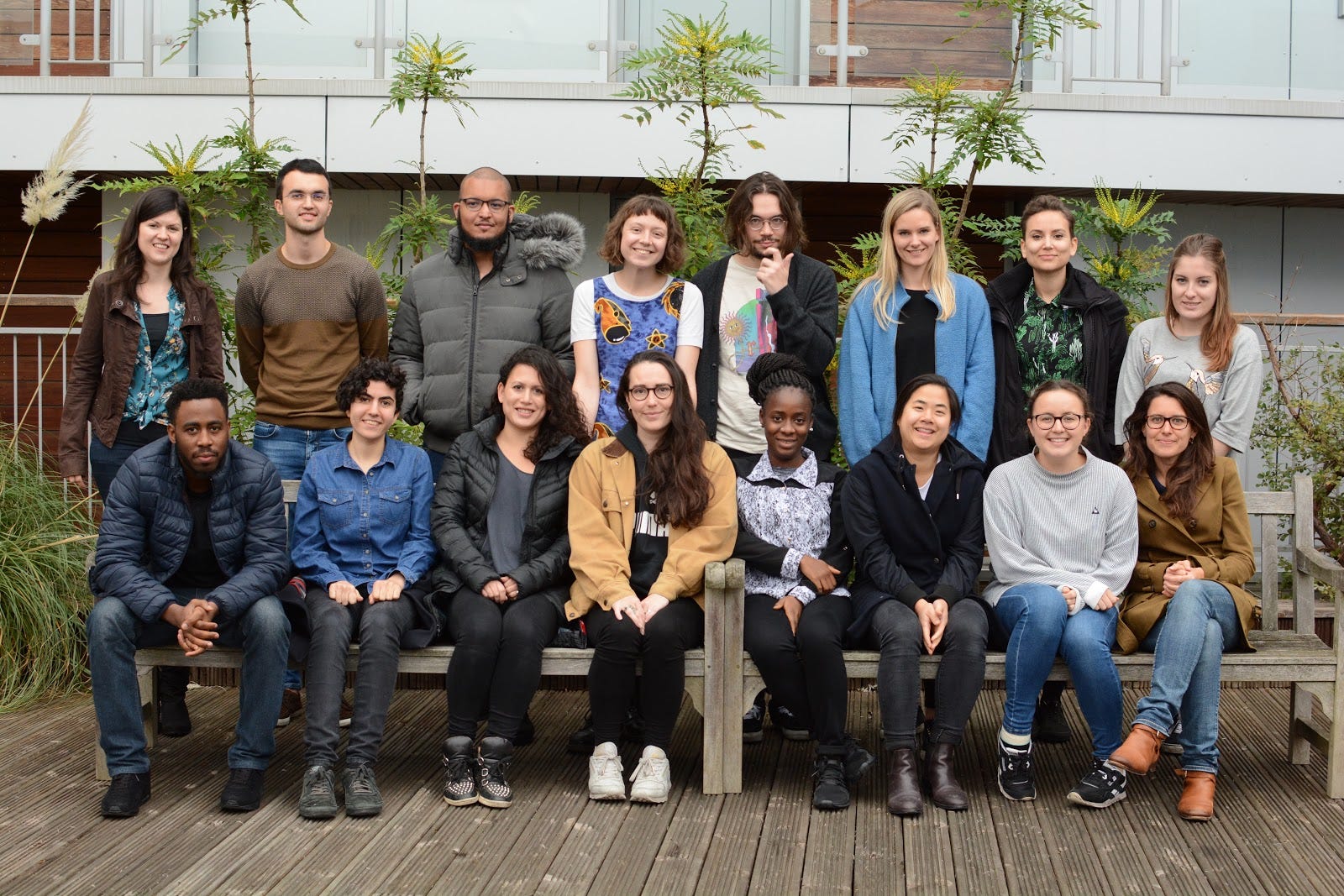
Johanna: I enjoyed my academic work in human rights but wanted my work to have more of a practical impact. While I was on maternity leave with my second child, I did an intro to coding course run by an organisation called Mums in Tech. I was just looking to learn a new skill, but really enjoyed it and started seeing how I could combine coding with my background to work in tech for good. While on the course, I read an article about Founders and Coders and thought it sounded like an amazing way to transition into a new career, so while I was back at my job after maternity leave, I started working on the prerequisites to get into Founders and Coders.
Rebecca: What were your first impressions of each other when you met on the course?
Becky: During the first eight weeks of the course, we worked together on three week-long projects. We enjoyed pairing on these short assignments and knew we’d like to work together on a longer project.
Rebecca: That longer project, of course, was WageCheck (the name of your project before you decided on Workerbird). Who came up with the idea?
Johanna: I pitched the idea of a national minimum-wage hour tracker to the rest of the cohort, and Becky chose to work on the project with me.
Rebecca: Tell me about the inspiration for your pitch.
Johanna: In one of our cohort’s first conversations with Dan about the final projects, he suggested workers rights as a potential topic. I was immediately interested because there is clearly so much scope for supporting workers with tech. Monday afternoons are set aside during the first half of the course to prepare for the final projects and I used some of this time to do initial research and reading. The Low Pay Commission had recently published its reports on the national minimum wage, which highlighted the fact that employers rarely report their own minimum-wage violations and that a lot of people paid under the minimum wage were not aware of what they were owed.
Rebecca: Becky, why did you choose to join Johanna?
Becky: I was keen to tackle an important problem that would require some research and to build an app that could have a profound impact.
“Most tech which is used in the workplace has been designed from the perspective of the employers. What we’re doing is different.”
Technically, I liked the idea that the project could be broken down into different sections, which meant that we could structure the project clearly and use all the technologies we had learnt.
Rebecca: Tell me about your brainstorming process. How did you get from idea to MVP?

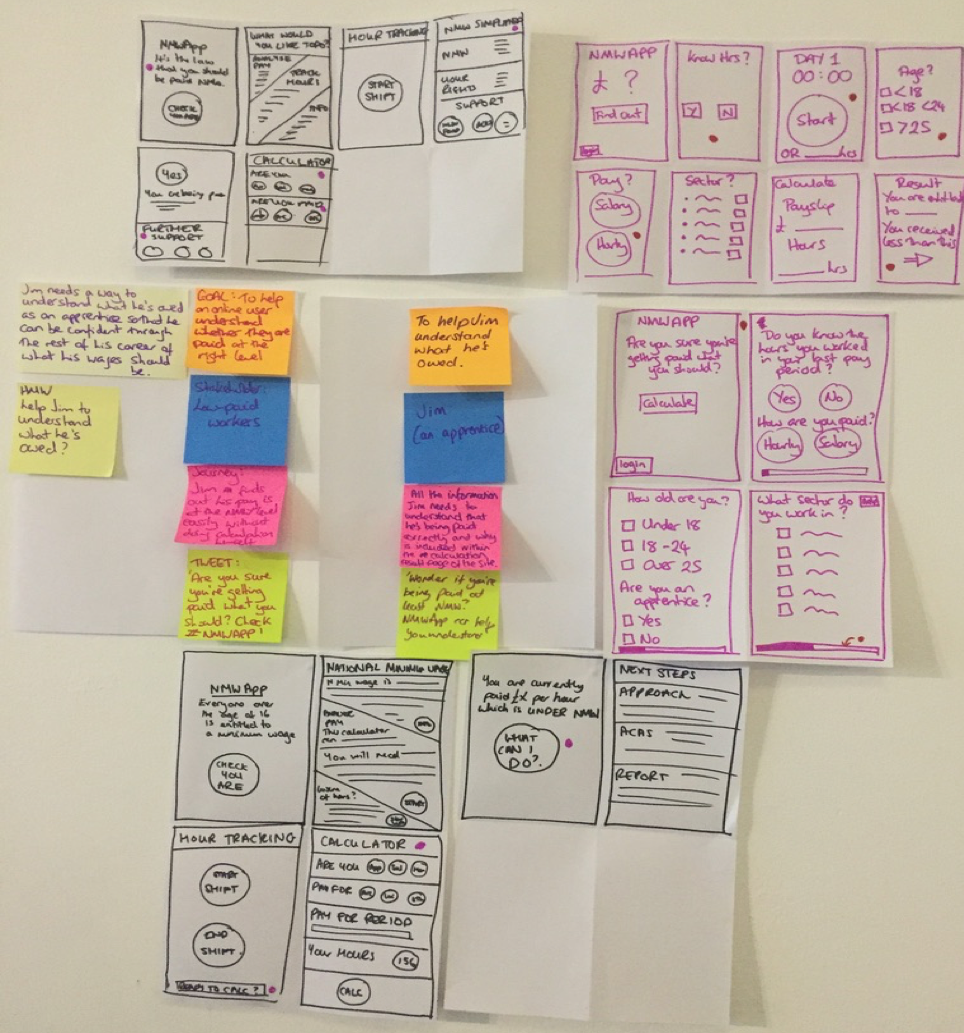
Johanna: We decided to build a mobile web application that would allow low-wage users to track their wage data. We thought tracking hours and working out whether a user’s hourly rate was above the minimum wage (which varies according to age and/or whether the worker is an apprentice) would both be narrow enough for us to complete within three weeks and could also be useful to organisations in the sector.
Rebecca: Step me through the phases of your student project.
Becky: During design week (which kicks off the second half of the course), we narrowed down the problem and focused on our users to understand what information we should provide and how we should structure the flow of the application before designing the screens of the prototype. By the end of the week we had a prototype that we tested on two people, and got valuable feedback on how we could improve the user experience.
We spent the next two weeks building the application. We realised there would be many different routes which the user could take through the application, so we broke down the stages of the build into the different routes (for example a new user that has their payslip, or a returning user who wants to track their hours), before connecting everything up at the end. We decided to use a technology that we hadn’t used before, SCSS, for the styling of the elements of our application, which we spent some time towards the end of the project learning and implementing. We were really proud of what we had achieved between us in just three weeks!

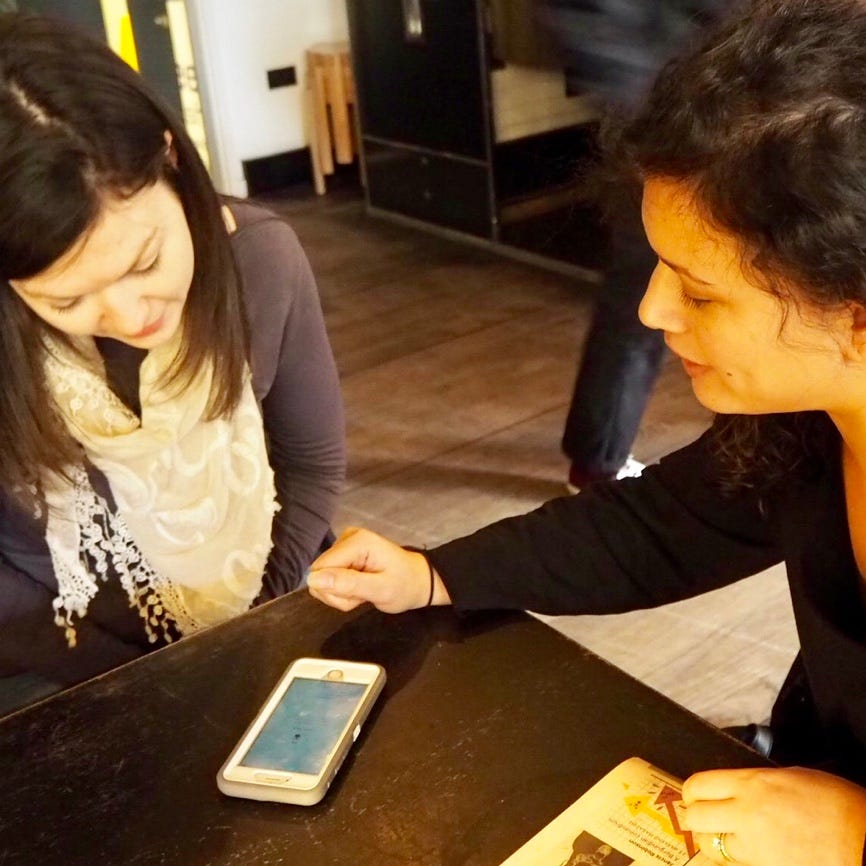
Rebecca: And how did you divide responsibilities on the project?
Johanna: The whole process was collaborative. We pair-programmed throughout the two weeks, so we were both involved in all the code and had a thorough understanding of the whole codebase. Since we were just two and we work well together it flowed quite well.
It set the foundation for our relationship as co-founders. We are lucky that with Becky’s background as an accountant she knew a lot on how to set up the finance and administration side once we got on the accelerator. I provide experience researching and forming partnerships, which are critical in the early stages of a new business.
Rebecca: What about challenges? Where did you run into trouble?
Becky: We started with the simple goal of helping our users track their hours with a timer, and then calculate once they had their payslip whether they were being paid at least the National Minimum Wage. However, once we started coding the various routes, we realised the calculation required several steps in order to allow users to either input their own hours manually or track using the timer functionality. We ended up with a lot of different pages and sometimes it was difficult to keep track of! Fortunately we were able to connect everything up by the end of the project and our somewhat complicated backend ultimately didn’t impact user experience.


Rebecca: Any other major breakthroughs?
Becky: We were most proud of the way we refactored the code for the point at which the calculation for whether or not the user is being paid minimum wage is done. Our code for that part was initially quite long and convoluted but we took the time to go back through and think about the best way to structure it so that it was easy to understand and maintain.
Rebecca: Did you get any help along the way from mentors at Founders and Coders?
Becky: Of course!Ronan McCabe (FAC5) did our code review. We communicated with him on Gitter, and he gave us some great pointers about functional programming, which helped a lot with the refactoring we mentioned before.
Johanna: In fact, notifications of his comments would come in as we were working. It was so reassuring to have his support!
Rebecca: When did you realise you were onto something?
Johanna: I told a former colleague, who’d worked with the Living Wage Campaign, about the project. He then told us he hadn’t heard of anything else like it.
Rebecca: So you decided to apply to the Future of Fair Work hackathon.
Johanna: During our final project, in which we worked together to build a chatbot for the nonprofit, Chayn, we had contacted Bethnal Green Ventures to see about getting funding to continue the WageCheck project after the course. They told us their hackathon was coming up the weekend after we graduated from Founders and Coders.
At the event, we were paired with two mentors, Phil Herbert from Thoughtworks and Daniel Stanley from Cohere Partners. There were also experts from unions, think tanks and other organisations who provided us with help and advice throughout the weekend. With their support, we developed a long-term vision for the application we’d built on the course. At the end of the weekend, we pitched a roadmap of functionality including data visualisation based on user results and support for teams of employees tracking wages so they could compile evidence of non-compliance by their employers together.
Rebecca: …and I understand you won the hackathon!

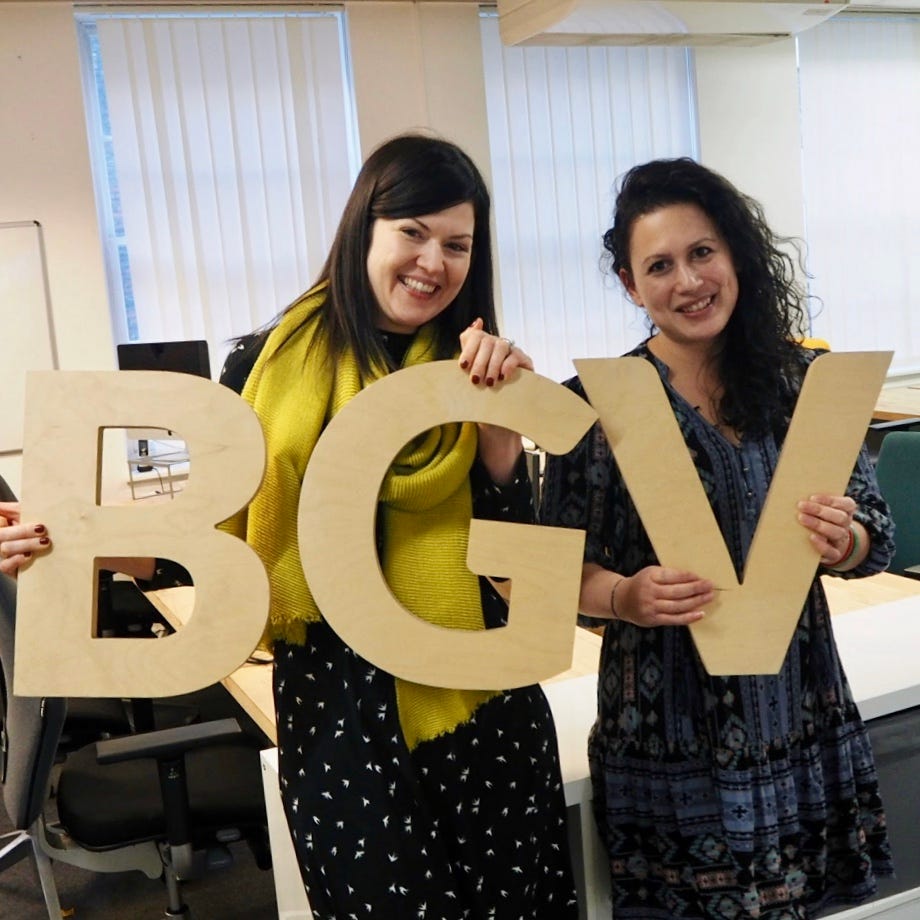
Johanna: Yep! We won first place, and as a result were invited to interview for the Bethnal Green Ventures accelerator.
Rebecca: I’d love to hear more about your time at Bethnal Green Ventures.
Becky: I can’t believe that we got onto a tech for good accelerator straight after graduating.
It was great to be part a community while building our startup. Meeting different mentors and getting their advice on our idea and business model was really useful, as everyone had different backgrounds and a unique perspective to offer. It was also helpful to explain our thinking to people on our cohort. This added to the community feel to the programme — everyone was really excited by what we were doing and that was really motivating.
We had initially decided to develop an application focussed on the care sector, as we knew there were sector-specific challenges which we could design for. However, because we wanted to ensure our application could have as much as an impact as possible, we pivoted and built a more flexible “version 1” of Workerbird that is applicable to all sectors.
Rebecca: While at Bethnal Green Ventures, you went back to Founders and Coders and worked with a team of student developers. How did that go?


Johanna: It was a great experience, and we would love to continue the relationship. The team took the Workerbird MVP on as their final project, and then did one two-week sprint all together as a graduate team. We are really pleased with what they have done and excited to start some testing of the beta version. Since we had been in the same position only four months earlier, we were keen to make it a real learning experience for them and also wanted to be responsive product owners. They came in to work with us at Bethnal Green Ventures for a couple of days and we went back to Founders and Coders for the design day, and it was a blast to all work together as a bigger team on those days.
We were lucky to have a team of developers from Thoughtbot mentor the build and they really helped with setting realistic goals at the beginning and a number of tricky issues throughout.

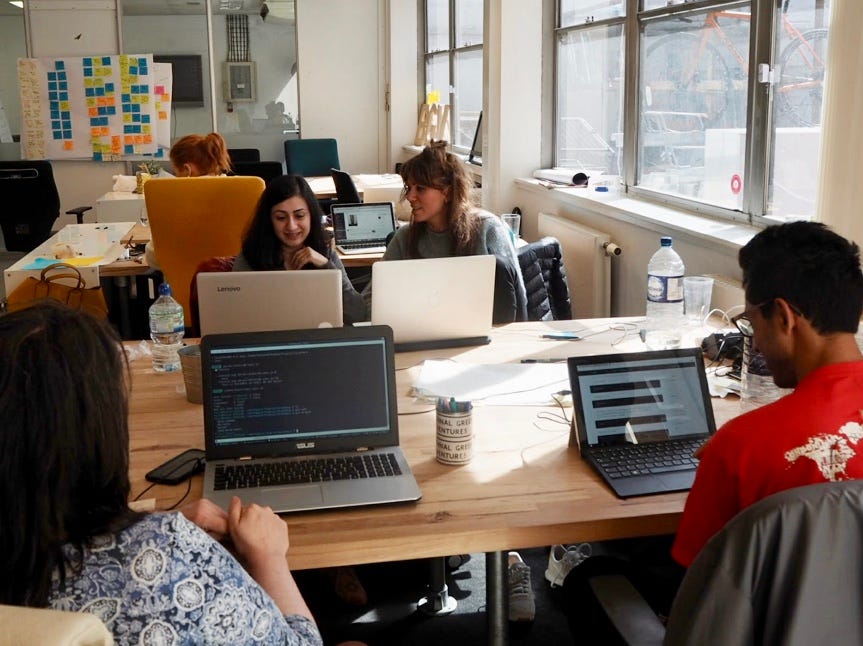
Rebecca: So what’s next for Workerbird?
Johanna: We’re applying for grant funding so that we can user test and develop the beta version further. We are also pursuing partnerships with leading organisations who support workers to develop and trial specific features with them.
Rebecca: As a former union organiser myself, I’m so inspired by your work at the intersection of digital tech and labor rights. Thanks for sharing your story with our readers, Becky and Johanna.
Becky: You’re welcome!
Johanna: I can’t believe the year we’ve had since beginning Founders and Coders in October 2017. What a ride!
相關推薦
From Coders to Founders: The Workerbird story
Becky (left) and Johanna (right) at the Bethnal Green Ventures demo dayRebecca: Becky and Johanna, thanks for taking the time out of your busy schedule to
From Jesus to Bitcoin: The history of modern economy
From Jesus to Bitcoin: The history of modern economyShortly before Passover, young Jesus arrived in Jerusalem. There, in the courtyards of the Temple, he s
from NEU to the society
過多 美的 進入 視野 neu 第一天 起航 成長 尊重 今天,正式的登上了我註冊已久的博客園,最初註冊園子得出發點是記錄生活點滴和學習工作的心得的,那就不忘初心,從頭開始吧。 從校園到工作,從東北到南方 我們畢業啦 誰說畢業遙遙無期,轉眼就要各奔東西。 是的,2017.1
Set the Round Robin IOPS limit from 1000 to 1
iopshttps://kb.vmware.com/s/article/2069356 http://www.enterprisedaddy.com/2017/02/set-round-robin-iops-limit-default-1000-1-using-powercli/ 1,Query the pa
Unable to build: the file dx.jar was not loaded from the SDK folder!
eclipse 執行 android 時失敗了,提示 Unable to build: the file dx.jar was not loaded from the SDK folder!確保dx.jar這個檔案在platform-tools\lib和選擇的開發版本lib中的檔案一致就可以;我用的 Andr
解決Eclipse報錯顯示Unable to build: the file dx.jar was not loaded from the SDK folder
由於最近通過SDK-Manager更新了build-tools,當要用到dx.jar這個包時,自動呼叫最新build-tools中dx.jar,但是執行android專案時Console卻提示: Failed to load C:\Program Files (x86)\And
TensorFlow測試程式報異常:FutureWarning: Conversion of the second argument of issubdtype from `float` to `np
使用安裝好的tensorflow-gpu 進行程式測試時出現異常: FutureWarning: Conversion of the second argument of issubdtype from `float` to `np.floating` is deprecated. In futu
bc_test_vc:The sum of the integers from 1 to 100 is 5050 .
//可以隨便更改的test函式,每次用完了就丟棄,隨時可以改。 void test(void) { int in1,in2,sum; cout<<"Input one integer:"<<endl; cin>>in1; cout<<"
eclipse升級Android SDK Tool版本到25.2.5後運行項目報錯Unable to build: the file dx.jar was not loaded from the SDK folder
com 但是 概述 details bsp 更新 href unable 解決辦法 概述 由於最近通過SDK-Manager更新了build-tools,當要用到dx.jar這個包時,自動調用最新版本Android SDK build-tools中dx.jar,但是運行a
[Android] How to open the Google Play Store directly from my Android application?
如果是在Android app 裡寫code, 可以使用: final String appPackageName = getPackageName(); // getPackageName() from Context or Activity object try { startActivi
[Android] Programmatically change input type of the EditText from PASSWORD to NORMAL
這還滿神奇的,有2個解法,一個是 Just for the people who are having same problem. Just add an extra attribute to that EditText programmatically and you are done. password
The Evolution of Artificial Intelligence: From ELIZA to Watson Insights Unboxed
In an earlier blog article I wrote about how human intelligence differs from artificial intelligence, namely human intelligence is general intelligence whi
A Big Tech Company Is Working to Free the Internet from Big Tech Companies
This story is for Medium members.Continue with FacebookContinue with GoogleMedium curates expert stories from leading publishers exclusively for members (w
Connecting the Blockchain dots from China to Germany
As much as I like to talk about Berlin being an important international blockchain hub, the basic logic of a hub might be contradictory to a decentralized
From Bookstore to Smart Speaker Behemoth: How Amazon Conquered The Bookstore and is Using it to…
While independent bookstores are experiencing a recent boom, chain bookstores like the kind Amazon Books resembles are clinging on for life. Borders, which
Huawei seeks to seize the AI throne from Silicon Valley
Chinese technology giant Huawei is taking its AI strategy up a gear in a bid to seize the throne from Silicon Valley incumbents. During HUAWEI CONNECT 2018
The Bumpy Path from Copywriting to UX
The Bumpy Path from Copywriting to UXIt doesn’t happen overnight. Your teammates don’t wake up, yawn, and decide it’s about time for you to write some inte
Get Smart: from Theory, to Practice, to the Future of A.I.
This piece accompanies a dedicated series from Ben around intelligence, A.I, and data-driven design and development in retail – all of which you can find i
The Metamorphosis of Silicon Valley CEOs: From Big to Boring
This story is for Medium members.Continue with FacebookContinue with GoogleMedium curates expert stories from leading publishers exclusively for members (w
The Evolution of Currency: From Salt to Crypto
A (very) brief history of currencyIt’s difficult for any single person or family to meet all their own needs and it’s more productive to divide up labour a
